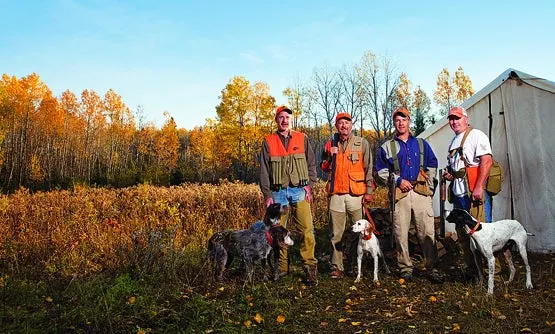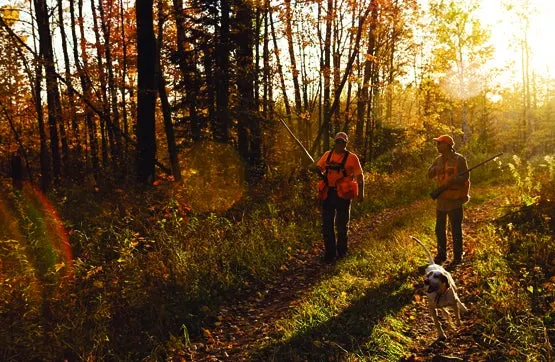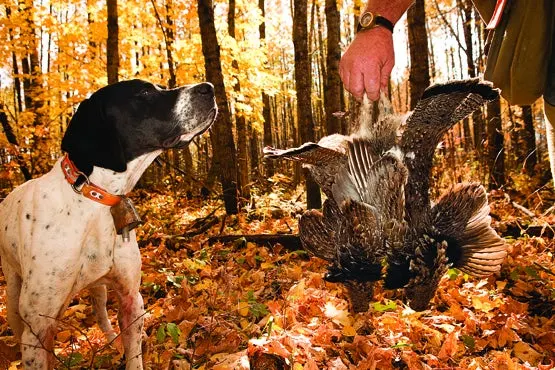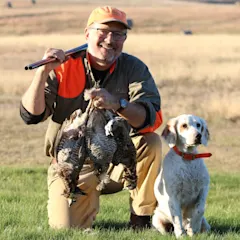The camp stood in a clearing ringed by tall aspens, and I arrived amid a cascade of golden leaves. It was early afternoon, and a south breeze tossed the treetops beneath a warm October sun. The two canvas wall tents had been pitched end-to-end on an east-west axis, and when I rolled back the flaps I found bunk beds on both sides, separate stoves for heating and cooking, and propane lanterns suspended from the ridgepoles.
Multiple coolers rested in the shade on the north side of the tents, and out back I discovered the camp’s crowning glory: a functional open-air shower, its pump powered by a heavy-duty marine battery. It was my first visit to grouse camp. Already I was impressed.
Every season, for close to 20 years now, a group of hunters has gathered to hunt birds out of a tent camp in northwestern Wisconsin, near the headwaters of the region’s three storied rivers: the Namekagon, the St. Croix, and the Bois Brule. This part of the state–comprising Bayfield, Burnett, Douglas, and Washburn Counties–boasts some 700,000 acres of public forest. Much of it is aggressively logged, ensuring a constant supply of the young, brushy, aspen-dominated woodland that’s synonymous with prime grouse and woodcock habitat. The tents go up around Oct. 1 and come down roughly two weeks later. That’s the heart of the grouse and woodcock season in this part of the world, a time of chilly nights and frosty dawns, of tattered clouds against blue skies and aspen leaves like wafers of sunlight, some clinging stubbornly to the treetops, others drifting down to earth.
I was ferrying gear into the tent when the camp’s two principals pulled in from hunting. Rich Wissink is the headman, the one who owns and sets up the tents, extends the invitations, and coordinates the various comings and goings so there’s enough food and beds to go around. A wildlife biologist who formerly worked for the Wisconsin DNR, he’s now the national youth program coordinator for Pheasants Forever. Pete Engman serves as second-in-command. Also a wildlife biologist, he’s stationed at the sprawling Crex Meadows State Wildlife Area near Grantsburg, Wis.
I’ve known Wissink since the mid 2000s. We met on the prairies of North Dakota, where we cut each other’s track hunting sharptails and hit it off immediately; sportsmen have a way of recognizing kindred spirits. “One of these years you’ll have to come to grouse camp,” Wissink said at the time. “It’s a blast. I have a photo of it as my screen saver. It helps get me through the long Wisconsin winters.”
Nearly a decade later, I finally made it to grouse camp. Wissink and Engman, each with a brace of woodcock from their morning hunt, took a seat in a couple of camp chairs, and I joined them, curious to know how this whole thing got started.
“It was in the early 1990s,” Engman said. He started to pluck breast feathers from one of his birds. “We were both working out of the DNR office in Oshkosh, and one day I found Wissink poring over a map of the state.”
Wissink started in: “I was looking for the biggest, wildest piece of land I could find. There was a patch in the northwestern part of the state that seemed to fit the bill. I was a little hesitant to tell Engman what I was up to. We didn’t know each other very well then. But when I did he got all excited.”
“I told Wissink that I’d hunted grouse up there and that it was really good,” Engman continued. “Tons of cover–and you hardly ever saw another hunter.”
“That sealed the deal,” Wissink said. “We’ve tried another spot or two, but this is the one we keep coming back to.”
Even though I hadn’t been here very long, I was beginning to understand why.

Straight to the PointAfter waiting for the afternoon heat to pass–we used the interlude to buck and split firewood–Wissink and I loaded up Tina, my petite English setter, and went for a little drive down a county road. And I do mean little. We’d barely gotten out of third gear when Wissink said, “This looks good,” and pulled over where an aspen cut skirted an alder swamp. As I struggled to keep Tina from bolting before I could hang a bell around her neck, I asked Wissink if he’d ever hunted this spot. He said no–but with the sly smile of someone who knows something you don’t.
I won’t swear to it, but I think Tina was on point before I’d closed the action on my Fox side-by-side. She was standing in the shadows beneath an enormous balsam fir, and though the bird, a woodcock, twittered away before either of us could get into position to shoot, the fast start boded well.
Tina then made a wide cast along the swamp edge. Her bell faded out, and in the process of locating her I flushed a grouse 15 yards ahead. It felt as if it took me an eternity to get the gun to my shoulder and fire, and as so often happens I had no idea if I’d hit the bird. But Tina materialized at the shot–she’d been on point, it turned out–and Wissink called, “She’s got your grouse. Nice shooting!”
It was a handsome gray-phase bird, and I praised Tina for retrieving it. We didn’t get another chance at a grouse before we headed back to camp, which meant that for a day, at least, I was batting a thousand.
After a cocktail hour, it was time to eat. I’d drawn kitchen duty that night. Like armies, grouse hunters march on their stomachs, and while I’d guessed that the grouse camp gang took their food seriously, I knew it for a fact the moment I saw Wissink’s battery of cast-iron cookware. This was not a crew, I learned, that believed in suffering for the sake of sport. The spicy hermit cookies I’d baked up for snacking purposes established my culinary cred from the start, and my venison stew spiked with ancho and chipotle peppers earned rave reviews. No one crawled into his bunk hungry, and though I can’t speak for the others, I suspect their dreams, like mine, were a swirl of fast-flying birds, staunchly pointing dogs, and desperate attempts to get a shotgun on target.

Upland RangersThe next morning, Engman, whose wirehaired pointing griffons impose a slower, more methodical pace, went off on his own, and I followed Wissink in my own vehicle. I felt as if my head were on a swivel as my gaze was pulled one way and then the other by the gorgeous cover sprawling in every direction, the aspens’ spangled yellow painted in broad meandering stripes across a landscape that, by all appearances, had no beginning or end. After about 9 miles, Wissink pulled into a wide spot on the right side of the road and climbed out of his truck. He was sporting that sly smile again.
“See anything you’d like to hunt?” he asked.
Wissink put down Ranger, a strong, savvy pointer, and we worked the edge of an oval aspen cut in a more or less counterclockwise direction. It was tough sledding in there; we squeezed between the tightly ranked trees, detoured around bristly balsam blowdowns, and bulled through clawing hazel brush. And with the hot sun rising sharply through an all but cloudless sky, we soon began unbuttoning shirts, rolling up sleeves, and stopping every so often to clean sweat-smeared shooting glasses.
Ranger, though, was unfazed. (Is there an athlete on earth more heat-resistant than a pointer?) After a period of diligent searching, his bell went silent. “Point!” Wissink said. We quickened our steps, eyes straining, until we spied Ranger and deployed for the flush. The grouse rocketed up on Wissink’s side. His first shot at the climbing bird was a clean miss, but his second appeared to connect. We marked the fall across a marshy swale, and when we got there Ranger was locked up near a patch of slough grass, presumably pointing dead. Wissink waded in–and the very undead grouse roared out, nearly flying right into my head. My first shot was a panicked stab; my second, though I lost sight of the bird the instant I fired, felt good. I even thought I heard the bird fluttering in the leaves. Ranger scoured the area thoroughly but came up empty.
“That,” Wissink said, “is a bionic grouse.”
Wissink had wanted to spend some one-on-one time with his younger pointer, Hank, and after he and I split up, a grouse of more mortal provenance flushed across a clearing where I was standing. I’m as capable as anyone of missing a wide open grouse shot, but this time there was no doubt about the outcome. Tina made a pretty point on a woodcock a few minutes later, and when it also tumbled at my shot I decided to call it an afternoon.
Saving GraceComparing notes while we lounged around camp, Wissink, Engman, and I agreed that grouse numbers weren’t nearly as robust as the preseason reports–topped by a 40 percent increase in the spring drumming count, the tool biologists use to get a handle on grouse population trends–had led us to believe they’d be. Instead of the hoped-for bonanza, we felt as though we were harvesting a crop from which the cream had already been skimmed. The prevalence of adult birds in our collective bag all but confirmed our suspicions. Grouse are challenging under even the best of circumstances, but when their numbers are thin and the ones you do find are almost without exception hard-bitten, squinty-eyed survivors, well, it doesn’t make things any easier.
The good news was that there were plenty of woodcock around. And as if any of us needed another reason to be grateful for this circumstance, that evening for dinner Engman demonstrated a way of grilling woodcock whole that was a revelation. You take a plucked woodcock and season it generously inside and out with celery salt, then grill it over medium-hot coals for about four minutes a side. That’s all there is to it.
You’d think that course might’ve taken the edge off my appetite, but when Wissink swung those skillets into play and fried up a mess of crappie and walleye fillets–crusty-crunchy on the outside, moist and sweet inside–I achieved a new personal best (or maybe worst) in sheer gluttony.
Smooth MoveIn the morning we all struck off in different directions. With enough attractive cover around to swallow a blaze-orange army, none of us harbored any concerns about stepping on one another’s toes or finding the kind of spots that make veteran grouse hunters weak in the knees. As a bird hunter, it’s an exhilarating, and increasingly rare, feeling when you know you’re free to hunt wherever you want to without having to pay or even ask permission for the privilege–and that you don’t have to settle for cover that’s second-rate, used-up, or worked over like a fighter who can’t get off the ropes. Now, looking north from a height of land, I saw a golden sea of aspen, dotted here and there with green islands of spruce, hemlock, and balsam fir. I turned Tina loose and plunged in, figuring to let what she found–or didn’t–dictate the course of the hunt.
What she found, quivering with intensity from the tip of her tail to the flaring nostrils of her nose, were enough woodcock for me to fill my three-bird limit in short order, despite some pretty shoddy marksmanship. Grouse, however, conformed to the all-too-familiar pattern: scarce and maddeningly wild. I had two flushes: one fleeting brown wraith that I saw, and the other nothing but muffled thunder. Both vanished into the black hole of a hemlock-tamarack swamp, where bitter experience told me there was no percentage in trying to follow them.
After a short drive, I glimpsed what looked like a pocket of young aspen. It was some distance off the county road, half hidden in a fold in the landscape behind a screen of hardwoods, but from what I could see it looked big enough to hold a grouse.
And it was. Tina pointed in a low, swampy spot, and the moment she came in sight the grouse blew out on a rising, left-to-right trajectory. Once again I had no idea if my aim had been true, but by the time I fought through to the spot, my little sweetheart already had the proof in her mouth. It was a lovely russet-hued bird, and I took it from Tina with the mixture of pride and elation that comes not just from bagging a grouse, but from knowing you did it right.
It turned out that a productive morning had been had by all, with Wissink’s two grouse and a limit of woodcock topping the leaderboard. As the sunny skies and unseasonably balmy temperatures continued to hold, we staked our dogs on tie-out chains so they could stretch, move, and simply enjoy a change of scenery from their crates. Flanked by Wissink’s three brawny pointers on one side and six on the other that belonged to Darren Britt, a grouse camp regular who joined us last night after a long drive from Georgia, Tina looked like a ballerina who’d taken a wrong turn and found herself on the same stage with a bunch of ripped-to-the-max bodybuilders.
That night, after we’d stuffed ourselves on grass-fed T-bones, the mood around the campfire was happy but contemplative. We watched the sparks swirl and rise as if they were aspiring to the stars. I’d be leaving the following afternoon, but with a week-plus to go at camp, things were still ramping up. Wissink said there could be as many as 10 hunters in camp in another couple of days.
As the fire burned to embers, I recalled an observation made by Gordon MacQuarrie, who grew up in this corner of Wisconsin, knew it intimately, and wrote about it better than anyone. MacQuarrie said that he didn’t go to the woods to rough it. He went to smooth it. The gang at grouse camp knew exactly what he was talking about.
From the September 2012 issue of Field & Stream magazine.
Photos by Nathaniel Welch


